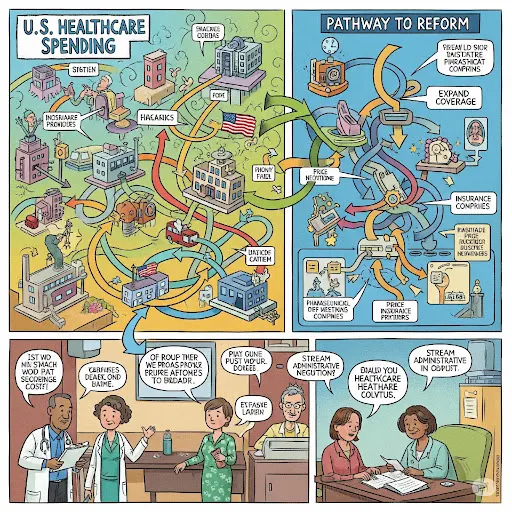Terrible Value for an Unmatched Price
The central issue with American healthcare is not whether we spend too much or too little, but that we get a terrible return on our massive investment. The U.S. spends far more than any other nation yet achieves mediocre health outcomes, creating a crisis of value that results in widespread medical debt and economic strain. The solution isn't just adjusting spending; it's about fundamentally reforming the system to prioritize health over profit.
1. The Spending Anomaly: A Global Outlier
The U.S. healthcare system's cost is in a league of its own.
* Spending as Share of Economy: The U.S. spends approximately 17% of its GDP on healthcare ($4.9 trillion). This is nearly double the average of other wealthy nations (which spend 11-12%).
* Per Person Spending: In 2023, the U.S. spent an estimated $13,432 per person. This is almost twice the comparable country average of $7,393 and more than double what is spent in the U.K. and Japan.
* A Recent Problem: This massive gap is not historic. U.S. spending was in line with its peers until the 1980s, when costs began to accelerate dramatically.
2. The Paradox: High Costs, Poor Outcomes
This record-breaking spending does not buy better health. In fact, it's the opposite.
* Life Expectancy: The U.S. has the lowest life expectancy among its peers.
* Avoidable Deaths: It has the highest rate of preventable deaths from conditions that could have been treated or avoided with effective care.
* Maternal & Infant Mortality: The U.S. has the highest rates of both maternal and infant deaths among high-income countries, by a wide margin.
* The Foundational Flaw: A key reason for these poor outcomes is that the U.S. is the only wealthy nation that does not guarantee universal health coverage, leaving over 28 million people uninsured. This leads to delayed care, worse outcomes, and higher costs for everyone.
3. Why Is It So Expensive? The Core Drivers
The exorbitant cost isn't because Americans get more care. It's because the system is structured to be wasteful and expensive.
* Administrative Bloat: The single biggest driver is administrative complexity. The fragmented patchwork of public and private insurers creates a bureaucratic nightmare that accounts for an estimated 30% of excess U.S. spending.
* It's the Prices: The U.S. pays drastically higher prices for the exact same things:
* Hospital and Doctor Care: Hospitals and physicians leverage market power to charge private insurance multiples of what Medicare pays.
* Labor Costs: U.S. physicians and nurses earn significantly more than their counterparts in other countries.
* Prescription Drugs: The U.S. has the highest drug prices in the world, paying two to three times more for branded drugs.
* Misaligned Incentives: The dominant "fee-for-service" model rewards the volume of tests and procedures, not the quality of care or how healthy patients are.
4. The Human Cost: A National Medical Debt Crisis
The system's high costs translate into devastating financial hardship for American families.
* Widespread Debt: 41% of U.S. adults (about 107 million people) have medical or dental debt. This is a uniquely American problem.
* Unequal Burden: The crisis hits hardest among Black (56%) and Hispanic (50%) adults, as well as low-income households.
* A Vicious Cycle: Medical debt is a leading cause of bankruptcy. To cope, people cut spending on food and necessities, drain their savings, and, most critically, skip or delay needed medical care, which makes their health conditions worse and more expensive to treat later.
5. Pathways to Reform
Several solutions have been proposed, each with different levels of impact and disruption.
| Reform Model | How It Works | Potential Pros | Potential Cons |
|---|---|---|---|
| Price Transparency | Mandate public posting of prices. | Provides data for research. | Has proven ineffective at lowering costs; data is unusable for consumers. |
| Price Negotiation (IRA) | Government negotiates prices for some drugs. | Substantial cost savings with direct impact on high prices. | Industry claims it will harm innovation (this is heavily disputed). |
| Public Option | A government insurance plan competes with private ones. | Increases competition and choice; could lower premiums. | Impact depends on design; could struggle to attract doctors or drive private plans out. |
| Single-Payer System | One government fund replaces all private insurance. | Universal coverage; massive administrative savings; strong cost control. | Requires large tax increases; potential for wait times; major political/economic disruption. |
6. The Bottom Line: Strategic Recommendations
The U.S. doesn't need to simply spend more or less—it needs to fundamentally reallocate resources from waste and inflated prices to high-value care. The path forward requires a courageous, multi-pronged approach.
* Control the Prices: Directly regulate and negotiate the prices of drugs, hospital care, and physician services.
* Simplify the System: Drastically reduce administrative waste by standardizing billing and moving toward simpler payment models.
* Reorient Toward Value: Shift from a "fee-for-service" model to payment systems that reward quality outcomes and invest heavily in primary and preventative care.
* Guarantee Universal Access: Ensure every resident has comprehensive, affordable health coverage. This is a prerequisite for an efficient and moral system.





No comments:
Post a Comment